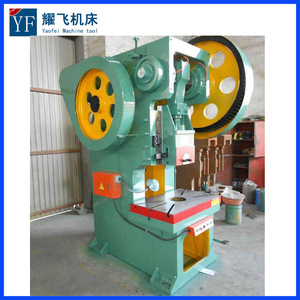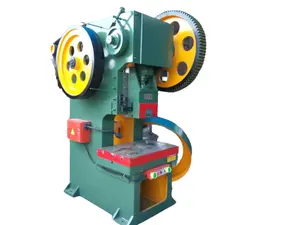(640 products available)

























































































































































































































































The J23 Series machine operates using a combination of mechanical movements and some electrical components. The types of press machines under the J23 Series primarily differ in their production capabilities and the designs of their machines. Here are some common types:
General Purpose Mechanical Press
The general purpose is to use a power train to change the direction of the force produced by the motor. Then, apply that force to the workpiece going through the mechanical press. This specific kind of press aims to do traditional shaping and cutting tasks on many materials. Manufacturers can use this press for many things on many kinds of materials. The general purpose mechanical power presses J23 have different sizes of machines to meet the needs of manufacturers.
Light Stamping Mechanical Press
Compared to the mechanical presses for general purposes, the light stamping mechanical presses are made with lighter materials. This allows the press machine itself to be lighter and take up less space overall. Because it is small, this model can easily be moved to different places on the manufacturing floor. Light stamping mechanical presses are usually used for stamping soft metals, plastics, and light gauge materials.
Mid Stamping Mechanical Press
The mid-stamping mechanical press is slightly heavier than the light press. It also has more power to do jobs related to shaping materials. The overall size of the presses varies depending on what kind of work needs to be done. Some designs have features that add to the flexibility of production. But they usually have faster processing times and give more accuracy than the light stamping press machines.
Heavy Stamping Mechanical Press
As the name indicates, this type of press machine is heavier and larger than all the previous types. The press machines possess higher voltage and more power to allow for greater production. Heavy stamping presses are usually used for harder metals at a higher capacity. They have more impact force and may feature a double crank for heavier workpieces and a higher production rate.
Open Back High-Speed Press
This type of mechanical press machine is commonly used in the production of deep-drawn parts. An open back high-speed press has a four-point drive mechanism that gives better control over the inertia, cutting down on ram-down time and returning faster. The press is made with minimal working components, which allows for less downtime, maintenance, and operating expenses.
Guillotine Press
A guillotine press machine allows for safe and fast cutting of large metal sheets at any angle. The cutting action of a guillotine machine occurs when the workpiece is held stationary and the machine descends onto the workpiece to cut it.
Due to their many features and advantages, the J23 series presses have a wide range of applications in several industries.
In the machinery industry
In the manufacturing industry
In the furniture industry
In the clothing industry
As can be seen, these machines have a pressing application for all types of industries. That is why it is crucial to invest in a quality pressing machine so that it can serve its purpose efficiently and with the utmost quality.
When selecting suitable J23 series press machines for the target customer base, several things should be considered.
Understand Different Usages and Fields
Users usually apply J23 presses in various fields. Their needs vary from agriculture to industry. When selecting J23 series presses, it is important to consider the user's application fields. Focus on the user's needs. Choose the type of machine that satisfies their specific needs. For instance, choose the J23 series press machine with features that meet automotive manufacturers' requirements for heavy-duty production lines.
Prioritize Safety and Quality
When selecting J23 series presses, prioritize machines with high safety standards and quality features. Give preference to those equipped with prominent safety features like an overload protection system, emergency shut-off button, as well as safety guards. Safeguarding operators is also very important. Go for machines manufactured to meet high industry standards.
Consider the Press's Versatility and Adaptability
As buyers' needs change with time, it is wise to consider the adaptability and versatility of the J23 series press being selected. It is good to choose an adaptable machine. One that can perform various tasks like blanking, bending, punching, or forming. Also, consider presses that have exchangeable dies. Those that offer different production capabilities.
Q1: What is a press machine's purpose?
A1: The purpose of a press machine is to reshape materials into desired shapes and sizes through the application of pressure. This heavy-duty production equipment caters to various industries by performing different types of works on metals, such as cutting, shearing, piercing, notching, punching, gouging, tearing, blanking, bending, and forming.
Q2: What are the types of press machines?
A2: There are lots of types of press machines available on the market. The J23 press machine series is one of them. Some other popular types include hydraulic press machines, mechanical press machines, trommel presses, rotary presses, eccentric presses, hot forging presses, and cold forging presses.
Q3: Are mechanical presses better than hydraulic presses?
A3: Mechanical and hydraulic presses have their benefits and drawbacks. As mentioned above, the J23 stamping press machines are mechanical presses. One of the benefits of mechanical presses is that they offer more consistent control over the material being shaped. They also provide a speed advantage, producing more parts per hour than hydraulic machines. On the other hand, hydraulic presses provide more flexibility. They can handle more significant and thicker materials and provide more precise control over the shape of the material being pressed. Hydraulic machines also have the advantage of being able to exert more substantial pressure.